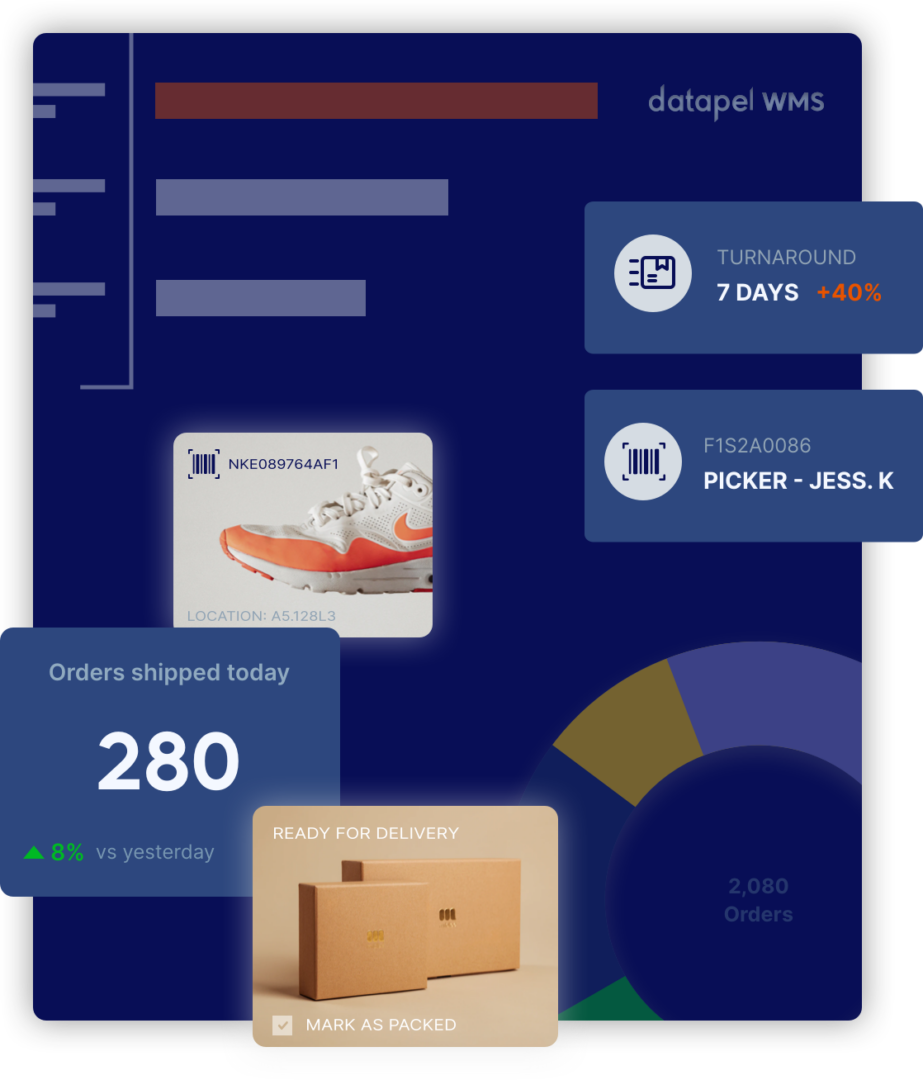10 Signs You Need an Inventory Management System
Contents
Managing your inventory effectively is not simply a bonus, it’s a necessity. As your business grows and expands and market demands shift, it becomes increasingly critical to have a strong inventory solution in place. Identifying the signs that your business needs such a system is crucial to staying competitive and maintaining smooth operations.
The management of inventory can be made easier by utilising an inventory management system like Datapel, which can provide the necessary insights and efficiency to make informed decisions and identify areas to encourage growth.
Here are 10 signs that signal it’s time to invest in an inventory management system and improve your game:
Signs You Need an Inventory Management System
1. Frequent Stockouts or Excessive Inventory

If you often face situations where your stock runs out frequently or your storage is filled with unsold goods, it’s a sign that you need to improve your inventory management.
By implementing an inventory management system, you can have accurate control over your stock levels. This system uses real time data tracking and demand forecasting to manage your inventory levels efficiently and maintain the right balance.
2. Manual Inventory Processes
If your small business is still using manual methods or spreadsheets for managing inventory, you are likely experiencing inefficiencies. Manual inventory management processes are time-consuming and prone to errors. By adopting an automated inventory system, you can streamline these processes, saving time, and reducing the likelihood of mistakes.
3. Inaccurate Inventory Records

If you notice discrepancies between your physical stock counts or sales orders and your inventory records or automated system, it indicates that your tracking methods need to be better. By implementing an inventory management system, you can ensure precise, real-time tracking of your stock, which can help you make better decisions and achieve greater order accuracy.
4. Challenges with Multiple Locations
Managing inventory across multiple locations or sales channels for large businesses can be complex. A unified inventory management software solution can help maintain consistent inventory tracking by providing a centralised overview of all stock.
5. Forecasting and Replenishment Issues
Struggling to predict inventory needs and automate replenishment signals the need for advanced inventory management. Management systems leverage real time data to forecast demand and ensure efficient replenishment.
6. Slow Order Processing
If you’re an online store finding it difficult to fulfil customer orders, consider implementing an integrated inventory and order management system. This kind of system optimises order processing, improving both speed and accuracy, resulting in higher customer satisfaction.
7. Lack of System Integration

Without integration between your inventory management and other business systems (e.g., accounting or eCommerce platforms), inefficiencies and inventory data inconsistencies can arise. A comprehensive inventory management system integrates seamlessly with other business tools, providing a cohesive operational view.
8. Compliance and Reporting Difficulties
If you are struggling to meet industry compliance standards or find it difficult to generate reports efficiently, it’s likely, that your current inventory management practices are not up to par.
Fortunately, modern inventory management systems are designed with compliance and reporting features, making these tasks much simpler and ensuring that your business adheres to relevant regulations.
9. Elevated Operational Costs
Inventory management systems can streamline warehouse operations, reduce costs of inventory storage, order fulfilment and administrative tasks, manage inventory, and enhance overall business profitability.
10. Labour Challenges and Efficiency
Labour issues such as high employee turnover rates and the requirement for extensive training time, are some of the indications that your business could benefit greatly from a new system with an inventory management system.
When manual processes are in place, employees can become overwhelmed with the meticulous details of tracking inventory, which can result in dissatisfaction and inefficiency. Furthermore, the dependence on manual systems often necessitates substantial training time for new employees, further worsening labour challenges.
Implementing an inventory management system can significantly enhance your business operations by recognising certain signs and acting upon them. This leads to better inventory accuracy, increased efficiency, and cost savings, which ultimately result in improved customer satisfaction and pave the way for sustainable growth.
By using the right inventory software system, businesses can navigate the complexities of modern commerce and remain agile and responsive to market demands.
Also read: The Benefits of Inventory Management System
Real-Life Success Story: Heebie Jeebies

The journey of Heebie Jeebies, a leading toy wholesale & retailer, encapsulates the transformative impact of adopting an inventory management system.
Prior to the implementation of such a system, Heebie Jeebies faced numerous challenges that are all too common in the retail industry. These included inefficiencies in managing a rapidly expanding product range and difficulties in tracking inventory across multiple locations, which ultimately led to stock discrepancies and operational bottlenecks.
Recognising the need for a change, Heebie Jeebies turned to an inventory management solution to address these critical issues. The decision was driven by a clear understanding of the signs that their existing processes were no longer sustainable, especially as they aimed to scale their operations and improve customer satisfaction.
The Turning Point
The turning point for Heebie Jeebies came with the realisation that their manual inventory methods were unable to keep pace with their growth.
This was particularly evident in their struggle with stock visibility and control across their retail and online channels. Additionally, the manual processes were laborious and prone to errors, affecting their efficiency and customer service quality.
Implementing the Solution
The implementation of an inventory management system was a strategic move that brought about immediate benefits. With the new system in place, Heebie Jeebies experienced a significant transformation in their operations. The most notable improvements included:
- Enhanced Inventory Accuracy: The system provided real-time visibility into stock levels across all locations, dramatically reducing the instances of stock discrepancies and enabling more accurate stock control. The MYOB integration eliminated double-entry and dramatically improved accuracy.
- Operational Efficiency: Automated processes replaced manual procedures, streamlining operations, and reducing the time and effort required to manage stock. This efficiency gain allowed Heebie Jeebies to redirect resources towards growth initiatives and customer service improvements.
- Scalability: The inventory management system equipped Heebie Jeebies with the tools necessary to manage their expanding product range and scale their operations without compromising on efficiency or customer satisfaction.
The Outcome
The adoption of an inventory management system with barcode scanning marked a new chapter for Heebie Jeebies, enabling them to overcome the challenges that had hindered their growth. The improvements in inventory accuracy and operational efficiency not only bolstered their bottom line but also enhanced their customer service, positioning them as a leader in their niche market.
“We have managed to quadruple in size and keep the same core team – it just delivers the efficiency we need to keep growing.” -Edward Thorp, MD of Heebie Jeebies.
This success story serves as a compelling testament to the benefits of recognising the need for and implementing an inventory management system. It highlights how businesses, regardless of their size or industry, can leverage technology to overcome common operational challenges and achieve substantial growth.
FAQ’s
Do I Need an Inventory System?
Yes, if you’re experiencing challenges such as frequent stockouts, excessive inventory, difficulty tracking stock across multiple locations, or if manual inventory processes are becoming too time-consuming and error-prone. An inventory system streamlines operations, provides accurate historical data for informed decisions, and supports business growth by ensuring that you have the right stock, at the right time, and in the right place.
What Are the Symptoms of Poor Inventory Management?
Symptoms of poor inventory control and management include:
- Frequent Stockouts or Excessive Inventory: Regularly running out of products or having too much stock indicates issues with demand forecasting and optimised stock levels.
- Inaccurate Inventory Records: Discrepancies between physical stock and inventory records suggest problems with tracking and data accuracy.
- Time-Consuming Order Processing: Slow order processing that impacts customer satisfaction can be a sign of inefficient inventory and order management practices.
- High Operational Costs: Elevated costs associated with storing inventory, fulfilling orders, or administrative overhead may indicate inefficiencies in inventory management.
- Difficulty in Forecasting and Replenishment: Struggles with accurately predicting inventory needs and automating replenishment orders highlight the need for a more sophisticated approach.
Who Needs Inventory Management Software?
- Businesses of All Sizes: From small businesses looking to scale operations to large enterprises seeking efficiency across multiple locations and sales channels.
- Retailers and E-Commerce Businesses: Those needing to manage a wide range of products and meet customer expectations for fast, accurate delivery.
- Manufacturers: Companies that need to track raw materials, work-in-progress, and finished goods to maintain production schedules and meet demand.
- Distributors and Wholesalers: Entities that require efficient stock management to fulfil orders accurately and on time, across diverse product ranges and customer bases.
- Any Business Seeking Growth: Organisations looking to optimise their inventory management practices to support growth, improve profitability, and enhance customer satisfaction.

In my role, I oversee the development of insightful blogs that delve into the intricacies of warehouse management. Each piece reflects my dedication to empowering businesses through informative content. Through my team’s extensive experience in the industry, we aim to bring clarity to the complexities of WMS, helping businesses make informed decisions.
Join me on a journey through the ever-evolving landscape of warehouse technology as we explore the latest trends, industry insights, and practical tips to streamline your operations. Feel free to connect, and let’s embark on a collaborative exploration of how WMS can redefine your business efficiency.
Cheers to innovation, efficiency, and the exciting world of warehouse management!







